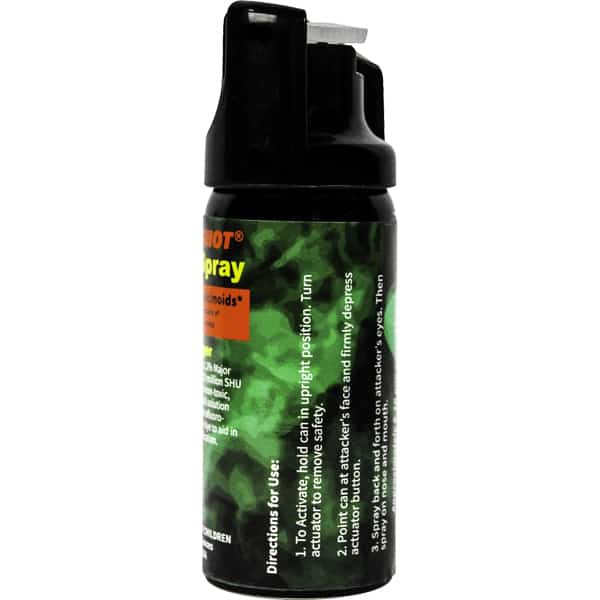
Brainstorm Security Shop

For Orders Over $199

On Any Of Our Products

Details On Refund Page
If you’ve ever wondered about the rules surrounding carrying mace spray in your checked baggage, there are a few key considerations to keep in mind. Understanding the specific regulations set forth by the TSA can help ensure a smooth and hassle-free travel experience. From permissible types of mace spray to packaging requirements and declaration processes, navigating this topic is crucial for travelers. Stay tuned to uncover essential insights that can make a significant difference in your travel preparations and peace of mind.
How does the TSA regulate the transportation of mace spray in checked baggage?
The TSA strictly regulates the transportation of mace spray to ensure safety and security during air travel. Mace spray, also known as pepper spray, is considered a self-defense tool, and its effectiveness in thwarting potential threats is well-documented. However, due to its chemical nature, mace spray is classified as a hazardous material by the TSA.
To comply with TSA guidelines, passengers are permitted to pack mace spray in their checked baggage but not in their carry-on luggage. When transporting mace spray in checked baggage, it must be properly sealed to prevent leakage and must meet the volume restrictions set by the TSA. Additionally, passengers are required to declare the presence of mace spray to the airline during the check-in process.

Passengers are allowed to transport only mace spray products that meet the specific criteria outlined by the TSA for checked baggage.
When it comes to permissible mace sprays, pepper spray is the most common type approved for self-defense purposes. Pepper spray, a non-lethal self-defense tool, contains oleoresin capsicum, an irritant that causes temporary blindness, difficulty breathing, and intense burning sensations when sprayed in the eyes or face of an attacker.
The TSA permits pepper spray in checked baggage as long as it’s in a container with a volume of 118 milliliters (4 fluid ounces) or less and bears a safety mechanism to prevent accidental discharge.
Other types of mace sprays, such as tear gas or bear spray, aren’t authorized for transport in checked baggage due to their potential for causing harm in an enclosed environment.
Ensure compliance with TSA regulations by adhering to the quantity restrictions when transporting mace spray in checked baggage. The Transportation Security Administration (TSA) permits mace spray in checked baggage as long as it doesn’t exceed 4 ounces (118 milliliters) per container and a total of 16 ounces (473 milliliters) per passenger. It’s crucial to verify the volume of mace spray to avoid confiscation or delays during the security screening process.
When storing mace spray in checked baggage, ensure it’s easily accessible in case inspection is required. Additionally, always check the expiration date of the mace spray before packing it. Expired mace spray may lose its effectiveness, rendering it potentially useless in case of emergency situations. Properly disposing of expired mace spray and replacing it with a new canister is imperative to ensure your safety and security.
When transporting mace spray in checked baggage, adhere to specific packaging requirements to comply with TSA regulations.
Proper storage of mace spray is crucial to prevent accidental discharge or leakage during transit. To meet travel restrictions, mace spray must be placed in a secure, leak-proof container. The container should be made of a durable material such as metal or hard plastic to prevent damage. Ensure that the mace spray container is tightly sealed to prevent any leaks.
Additionally, the container must be placed in a clear plastic bag before being packed in your checked baggage. This secondary layer of protection helps to contain any potential leaks and allows for easy inspection by security personnel.
During the declaration process at check-in, you must inform the airline staff if you’re carrying mace spray in your checked baggage. Airport security regulations require passengers to disclose any potentially hazardous materials like mace spray to ensure safe and secure travel for all passengers and crew.
Baggage screening procedures are in place to detect prohibited items, including mace spray, which could pose a risk during the flight. By declaring the mace spray at check-in, you allow airport security to handle the item appropriately and prevent any potential incidents onboard the aircraft.
Failure to declare mace spray in your checked baggage can lead to serious consequences, including delays, fines, or confiscation of the item. It’s crucial to follow all airport security regulations and cooperate with airline staff during the check-in process to ensure a smooth travel experience for everyone.
Remember that safety is paramount, and by adhering to the declaration process at check-in, you contribute to maintaining a secure environment for all passengers.
To handle mace spray safely, be aware of proper techniques and precautions to minimize the risk of accidental exposure or misuse. Proper storage is crucial when handling mace spray. Store it in a cool, dry place away from direct sunlight and sources of heat to prevent deterioration or leakage. Always keep mace spray in its original container and never transfer it to unmarked or food containers to avoid confusion.
In emergency situations, act quickly and decisively. If accidentally exposed to mace spray, move to a well-ventilated area and flush the affected area with water. Remove contaminated clothing and wash skin thoroughly. Seek medical attention if symptoms persist or worsen.
If using mace spray for self-defense, aim for the attacker’s face and eyes from a safe distance. Practice using the spray beforehand to familiarize yourself with its operation. Remember that mace spray is a tool for self-defense and should be used responsibly and ethically.
Certain ingredients are prohibited in mace spray formulations due to safety and regulatory concerns. Ingredient restrictions are in place to ensure the safety of individuals and comply with legal implications. Safety precautions dictate that mace sprays shouldn’t contain substances that could cause harm beyond their intended use.
Commonly prohibited ingredients include tear gas, chloroacetophenone, and other toxic chemicals. These substances are restricted due to their potential to cause serious harm or legal issues when used in self-defense situations.
When considering international travel, it’s crucial to be aware of the specific regulations regarding mace spray ingredients in different countries. Certain ingredients that are permissible in one location may be prohibited in another, leading to potential legal consequences if not adhered to.
It’s essential to research and understand the legal implications of carrying mace spray with specific ingredients when traveling internationally to avoid any complications or penalties.

When traveling internationally, it’s crucial to thoroughly research and understand the specific regulations regarding mace spray possession and ingredients in each country you plan to visit. Customs regulations vary widely between countries, and some nations may have strict guidelines on the possession of self-defense items like mace spray. It’s essential to check with the customs authorities of the countries you’re traveling to in order to ensure compliance with their regulations.
Furthermore, airline policies also play a significant role when it comes to carrying mace spray internationally. Different airlines may have varying rules regarding the transportation of self-defense items in checked baggage. Before packing mace spray in your luggage, be sure to review the policies of the airline you’re flying with to avoid any issues during your journey.
Failure to adhere to the customs regulations or airline policies regarding mace spray could result in confiscation of the item, fines, or even legal consequences. Therefore, it’s imperative to be well-informed and prepared before traveling with mace spray internationally.
Understanding the liability and legal implications associated with carrying mace spray in checked baggage is crucial for international travelers. Legal consequences can arise if mace spray is prohibited in the destination country or if there are restrictions on its possession. It’s important to research and comply with the laws and regulations of both the departure and arrival locations to avoid liability risks.
Carrying mace spray in checked baggage can lead to serious legal implications, including fines, confiscation of the spray, and potential legal actions. Liability risks may also extend to civil lawsuits if the mace spray causes harm to individuals or property during transportation. International travelers should be aware that different countries have varying laws regarding the possession and use of mace spray, so it’s essential to thoroughly understand the legal landscape before packing it in checked baggage.
To mitigate legal consequences and liability risks, consider alternative options such as purchasing mace spray at the destination if needed, or exploring non-lethal self-defense alternatives that are legal in both the departure and arrival locations.
Explore the following additional resources and frequently asked questions to gain more insight into the regulations and considerations surrounding carrying mace spray in checked baggage.
When storing mace spray in checked baggage, it’s crucial to adhere to specific regulations. Check with the Transportation Security Administration (TSA) for the most up-to-date guidelines on carrying mace spray.
Some storage options may include using a lockable container to prevent accidental discharge and ensuring the mace spray is easily accessible for emergencies.
If you’re traveling with a companion, ensure they’re aware of the location of the mace spray in the checked baggage in case of emergencies. It’s essential to discuss safety protocols and procedures beforehand to handle any unforeseen situations effectively.
In conclusion, when transporting mace spray in checked baggage, it’s crucial to adhere to TSA regulations, including volume restrictions, proper packaging, and declaration to the airline. Failure to comply with these guidelines can result in fines, confiscation, and legal consequences.
Understanding the rules and requirements for carrying mace spray is essential to ensure safety, compliance, and a smooth travel experience.

Brainstorm Security Shop
1867 Caravan Trail
Ste 105
Jacksonville, FL 32216
Call us toll free: (800) 859-5566